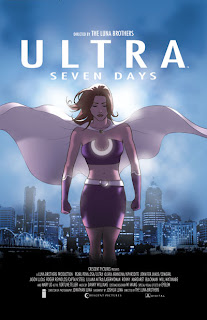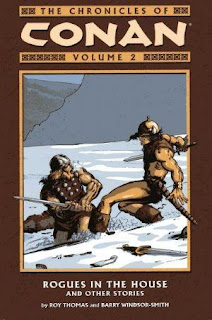 Writers:
Writers: Stan Lee, Mark Waid, Denny O’Neil, David Michelinie, Mark Gruenwald, Roy Thomas, Dann Thomas, James Robinson, Kurt Busiek, and Roger Stern
Artists: Don Heck, Ron Garney, Luke McDonnell, Mark Bright, Bob Layton, Kieron Dwyer, Jim Valentino, Colin MacNeil, and Patrick Zircher
Collects: Tales of Suspense #58,
Iron Man #172 & 228,
Captain America #341 &
Annual #9,
Tales of Suspense #1,
Iron Man and Captain America Annual 1998,
Captain America: Sentinel of Liberty #5-6
Published: Marvel, 2010; $24.99
With such a boring title, you couldn’t be blamed for thinking that
Iron Man/Captain America is probably a pretty run-of-the-mill book. As it turns out, though, it’s actually pretty unique as far as “best of” collections go, in that it maintains a specific theme across the entire book beyond simply “stories that happen to feature the characters in the title.” While not every story is exactly perfect, this does make for a nice, unified reading experience overall.
We start off with an early Iron Man tale by Stan Lee and Don Heck, in which a case of mistaken identity (involving Kraven the Hunter and the Chameleon, apparently on loan from the Spider-Man comics) leads Iron Man and Captain America to duke it out in a construction site. This issue is classic Marvel at its best, with solid action scenes by Heck and some nice character drama involving Iron Man supporting characters Pepper Potts and Happy Hogan. While it’s been reprinted plenty of times elsewhere, its inclusion here is more than welcome.
Next, we jump forward nearly fifty years (in terms of publication date, that is) to a two-part story from Mark Waid’s
Captain America: Sentinel of Liberty series. It actually takes place shortly after Captain America is discovered by the Avengers, though, which explains why it’s positioned here in the book. In essence, this is meant to be the characters’ first non-Avengers team-up and the real start of their friendship. It begins with Iron Man assuming that Captain America has lost his edge after being trapped in ice for so long; however, Cap is the one to save the day when alien robots take control of Tony’s mind and send him on a rampage through New York City.
The next two issues come from a period of Marvel history that I’m not quite as familiar with, especially when it comes to the Avengers’ corner of the universe. The first story, reprinted from a Denny O’Neil-written issue from 1983, actually features Jim Rhodes as Iron Man – at this point, Tony’s alcoholism had apparently so consumed him that his friends deemed him too much of a risk to allow him to continue suiting up. Even Captain America is in the dark as to who’s under the helmet, which makes their interactions all the more interesting as the two heroes scour some of NYC’s seedier locales for a drunken Tony.
The second issue, written in 1988 by David Michelinie (with art by Mark Bright and Bob Layton), sees Tony back on his feet as Iron Man, but facing even greater problems than his own inner demons. Terrorists have somehow gotten hold of his Iron Man technology, and in an effort to prevent even more of it from falling into the wrong hands, he resolves to take out the Guardsmen, a group that guards a super-villain prison using Stark technology. Personally, I don’t understand why he didn’t just try talking to the people who run the prison and come up with some alternative security measures, rather than waging all-out war on the security guards and accidentally freeing a handful of super-villains in the process.
Captain America doesn’t see the logic in Tony’s plan either, and the two friends end up coming to literal blows over it. A short follow-up written by Mark Gruenwald, originally published as a back-up story in
Captain America #341 sees Cap trying to arrest Iron Man for his actions and coming up empty-handed when Tony flees his own apartment. Between this and the other ‘80s stories, I get the impression that Tony Stark spent most of that decade being a grade-A jerk.
Another story, taken from
Captain America Annual #9 and written by Roy and Dann Thomas, is the first part of “The Terminus Factor,” a plotline that ran across several different characters’
Annual issues in 1990. The other four parts aren’t collected here, but if the first part is any indication, that’s probably a good thing. The story is about Cap dealing with a town that turns into a horde of zombies after eating bad trout at a fish-fry – among them, Iron Man. Yes, that’s really the plot: zombies and a fish-fry. There’s even a bear that turns into a zombie after eating one of the fish. The less said about that, the better, I think…
The next story, by far the longest in the book in terms of page count (though it’s a pretty quick read), comes from one of those standalone original graphic novels that Marvel seemed overly fond of putting out in the 1990s. Written by James Robinson (who at the time was just beginning his legendary run on
Starman), it’s a fairly boring story about Captain America and Iron Man teaming up to fight an old enemy from Cap’s WWII days who plans to assassinate a Japanese politician. Since this is the ‘90s, there’s also a generic cyborg assassin who fails to come off as even slightly menacing.
I actually found this story to be a pretty annoying read since Robinson writes almost exclusively in one-word or two-word sentences. I get that he wanted the dialogue to be “punchy” or “powerful” or whatever, but after a while I just felt like I was reading a comic about cavemen in robot suits. The artwork is standard fare for these OGNs, in that it’s much more stylized and elaborate than the story warrants. Colin MacNeil is a good artist, to be sure, but his painterly style in this comic just seems self-indulgent when paired with Robinson’s mediocre script. Still, I guess it’s nice to see the OGN reprinted here, since it’s not worthy of its own trade and I can’t think of anywhere much better to put it.
The final issue collected in
Iron Man/Captain America is the characters’ joint
Annual issue from 1998, which is plotted by Kurt Busiek and Roger Stern and scripted by Mark Waid. Whereas the 1990 Captain America Annual was substandard (and zombie-filled) fare, this one hits the mark dead-on. It’s also quite important in terms of Marvel continuity, as it’s the issue where Iron Man essentially wipes the knowledge of his secret identity from every mind on the planet.
Cap is predictably angry when the truth comes out, leading him into a major moral dilemma when he’s faced with a similar situation during the characters’ fight with MODOK later in the issue. This story marked the first time in
Iron Man/Captain America that I could actually see
some logic to Tony’s argument, although in the end I still had to side with Cap. The art in this issue is by Patrick Zircher, who brings the same clean (if not entirely remarkable) style he did to
Iron Man: Deadly Solutions.
I think
Iron Man/Captain America was published in large part to be a vehicle for this last story – since Marvel seems intent on collecting the two characters’ solo series from 1998 onwards, this was an important issue that had to be placed somewhere, and putting it here prevents Marvel from having to collect it twice. While I don’t think too much knowledge of either solo series is required to enjoy this particular issue, I
would recommend reading it if you’re following the other late-‘90s collected editions for either character, since the 1998
Annual is unlikely to be reprinted elsewhere.
What I like about this trade is that it’s about more than just the characters’ partnership through the years – in fact, it’s more concerned with the fact that Tony Stark is constantly putting that relationship to the test with his actions. With such a specific theme, it’s hard to see why Marvel didn’t slap some kind of subtitle on the book to separate it from the pack a bit (even if it was a completely lame one…a little individuality never hurts). I also can’t help but wonder why the editors of the book didn’t choose issues that portray Iron Man in a better light, but I’m not complaining; the stories they did choose, with only a few exceptions, tell a surprisingly cohesive story, one worth a look by fans of either character.
Rating: 3.5 out of 5
 Writer: Joshua Luna
Writer: Joshua Luna







